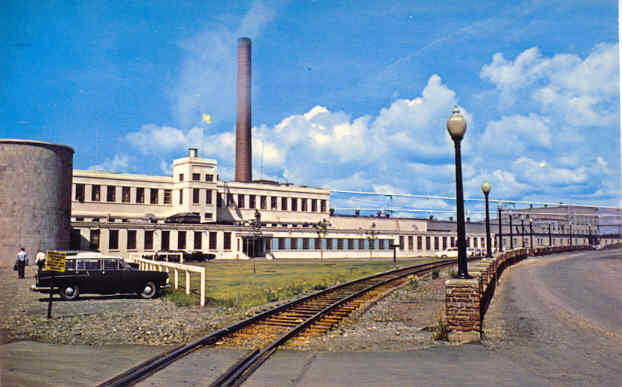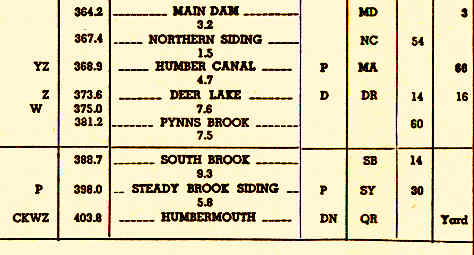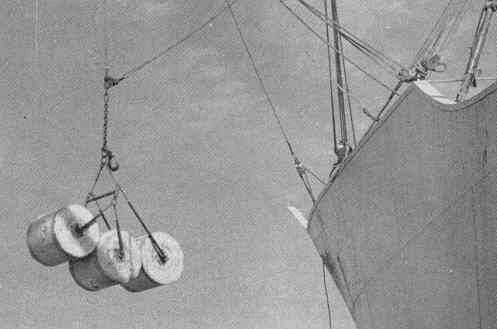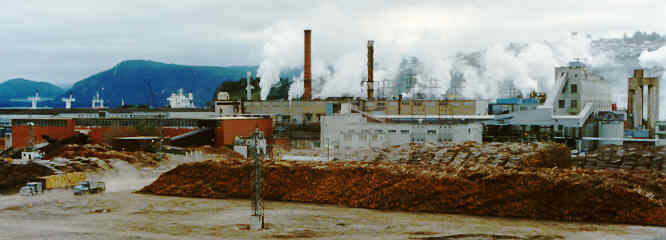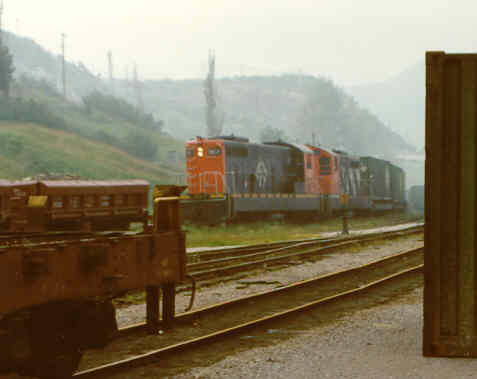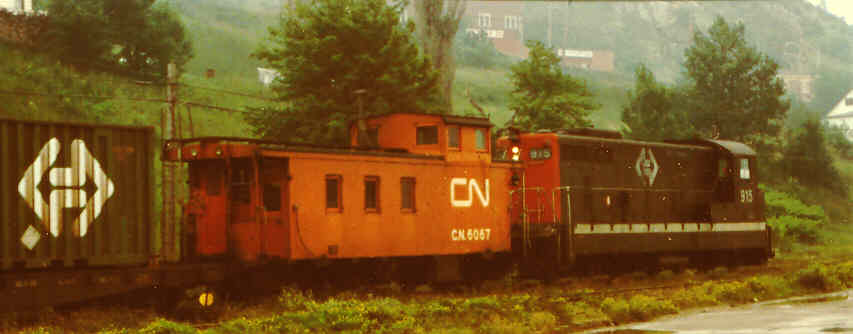The Newfoundland Railway and Resource Development
Hydro-electricity and Newfoundland Newsprint for the World
Those controversial land grants ...
Following practices used in Canada during railway building,
the Newfoundland government awarded land grants to the Reids as part
of the various railway building and operating contracts.
If you were the Newfoundland government at that time, unused wilderness
land was much more plentiful than cash.
The size and location of these grants was often misunderstood
... and occasionally legitimately controversial.
Here's how they were generally awarded :
- 5000 acres per mile of railway.
- Each block was 1-2 miles wide and 8 miles deep.
- The blocks alternated : from one side of the railway right-of-way
to the other.
- ... so for 1-2 miles on the right side ... the next 1-2 miles
on the left side.
- A 1 mile by 8 mile block equals about 5000 acres
- If the land was "unsuitable", another location could be selected.
By the 1920s, the Reids had over 2.5 million acres
of land.
For comparison, the CPR received 25 million acres via
their grants.
While much of the CPR prairie land could be resold as farm
land or town lots, most of the Newfoundland land grants were covered
with stands of black spruce, white birch, and balsam.
At one point, the Reids owned a little over 25% of the potentially
productive forests of Newfoundland ...
... Hmm ...
Who wants all this wood ? ... Canada's close
... but it has lots of lumber already ... dang !
And how would we move it around ?
We've got this railway
corridor and excellent water transportation at the island's edges.
If
we drive fine lumber logs down rivers from the forest, they would probably
be bashed into pulp !
And those local politicians want us to diversify the economy .
We should talk to the financial boys with the deep
pockets in London
... if we could get them
to put down their newspapers long enough !
Opening in 1909, the Anglo Newfoundland Development
Company pulp and paper mill at Grand Falls produced
27,000 tons per year for its owner in Britain - a publisher who wanted
to avoid any possibility of newsprint shortages or price spikes. Grand
Falls was also considerably closer to Britain for shipping this bulky
cargo than continental North America.
Consider the life-cycle of Newfoundland newsprint ...
Back in London on his "AND Company's" newsprint ... British
journalist and Amalgamated Press publisher Alfred Harmsworth (later
Viscount Northcliffe) printed the Daily Mirror, the
Daily Mail, and The Times, among others, at the
beginning of the 20th Century.
His papers generally catered to the new popular audience created by
compulsory education in Britain.
Blazing British World War I debates on Lord Kitchener's performance,
conscription, shortages of artillery shells at the front, and food rationing
were touched off by Newfoundland newsprint.
... and in the days that followed, some of the same newspapers
- printed on Newfoundland newsprint - would facilitate nutrition of the
same popular audience's fast food snacking ... by serving as absorbent
packaging for greasy fried "chips".
Electricity for the north
To mash up all that wood for British consumption two hydro-electric
power stations were developed along the Exploits River in 1908 - one
at Grand Falls and another at Bishop's Falls (maps coming up).
To put you in the mind of electrical generating technology back then,
here is a cross-section of a contemporary power station at Grand'mere,
Quebec from 1913 ...
Permanently located above the rows of heavy components are high capacity
cranes ... which travelled along rails or guideways ... and were used to
pull out heavy equipment for periodic maintenance or repairs.
At the right, one hovers over the spillway gate area.
At the left, one stands by over the generating machinery.
The turbine blades will be spun by the water. Above the turbines, the dynamos
(generators) - when engaged - will produce electricity. The power proceeds
up through the dam as it is prepared for transmission from the towers at
the top of the powerhouse.
Building this type of installation inland in Newfoundland meant that
all these heavy manufactured components would have to be taken to the dam
location for final assembly ... by rail. Generally, so would the aggregate
and cement for the construction of the dams and powerhouse.
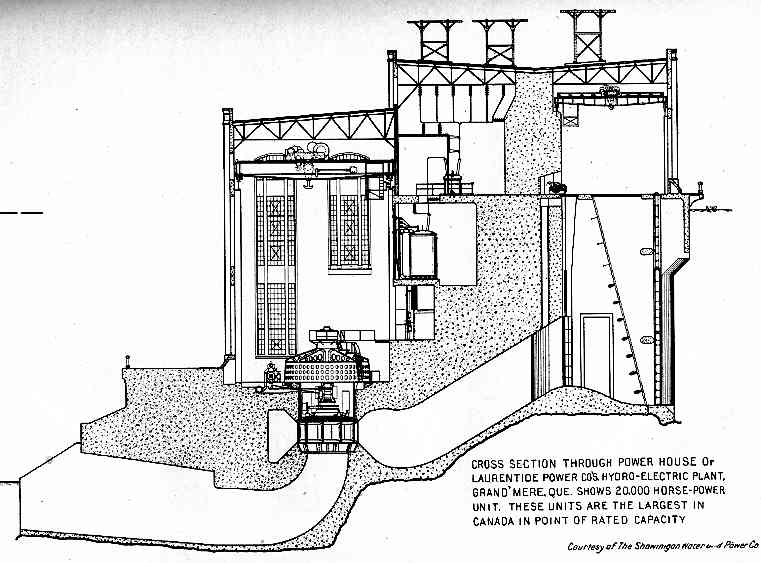
Besides powering the mills, surplus electricity from the local
hydro stations at Grand Falls and Bishop's Falls allowed people in the
surrounding area to get their first opportunity to use electricity at home
- particularly during the long, dark wintery nights ...
Everyone must have run out and bought central vacuums, whirlpool tubs,
and home theatre systems to celebrate !
The Grand Falls mill in the late 1960s with
its narrow gauge Newfoundland Railway track.
To give you a rough idea ...
most of the forestry and related industry was north of the word
"Newfoundland". Zooming in to that section of track, in the 1920s ...
Zooming in to that section of track, in the 1920s ...
The dotted black line is the railway and you can see Grand Falls
with the Exploits River flowing by it at the right side of the map.
Little branchlines can also be seen up to ports at Botwood
and Lewisport and also down to Millertown.
The AND Company owned and ran the Millertown (for wood supply)
and Botwood (seaport) branches with its own equipment.
Another paper mill ... this time at Corner Brook
To the left side of the map above, you can see Grand Lake, Deer Lake,
Humber River, Humbermouth and Humber Arm.
... and something was about to "Put the Hum on
the Humber " ... Premier Squires and the rest of them sure
had a way with words back then.
More power to you
It seems Corner Brook almost didn't happen. Back in 1915, the Newfoundland
Power and Paper Company - in which the Reids had an interest - was planning
to build a dam and redirect the natural outflow of the Grand Lake at its
northern tip... to a power station near the northeast tip of Deer Lake.
(This project was eventually started in 1922.)
Following the practice previously used at older Quebec locations and at
Grand Falls, the paper mill will would have been built right
beside the power generation location in the Deer Lake area, to minimize
transmission losses of the high voltage alternating current.
Also around 1915, grading for a railway line was begun from Deer &
Grand Lakes to Bonne Bay - a potential seaport. You can see the faint line
going through the "u" in "Humber River". The railway line construction was
stopped shortly thereafter.
What changed?
It seems likely that the recent refinement
of modern transmission line insulators ... dangling vertically like a
string of bells or beads (suspension-type insulators) from a high tension
tower ... made it clearly feasible for the project developers to transport
high voltage AC power longer distances without significant losses.
The old ceramic insulators which screwed onto pegs (pin-type insulators)
on crossarms were out !
THE BOTTOM LINE $$$ :
By deciding to bring the electricity to the Corner Brook mill at tidewater,
it would be possible to load the large rolls of newsprint DIRECTLY onto
ships for sea transport, rather than FIRST hauling them by rail to an ocean
port and THEN transferring the rolls to ship - as was being done by the AND
Company in the Grand Falls area.
... uh, where were we ? ... OK! so other stuff was going on in Newfoundland as well,
eh? ...
And they had to finish off World War I, too (more about that later) ...
And the Reids were really, really tired of losing money
as operators of the wilderness railway ...
Between 1920 and 1923 the Reids tried a joint arrangement with the government
to keep things going ...
In May 1923, the Reids shut down the railway to illustrate
to the government that they were serious.
- W.D. - his son was killed in
1916 in WW I and W.D. left the company due to stress in 1917.
- H.D. , and
R.G. Jr.
Local railroaders were apparently irked by the "British attitude" of some
of the visiting Armstrong Whitworth personnel toward the relatively primitive
colonial railway and the unconventional resourcefulness of its operating
personnel as the cultures clashed again.
Government subsidies for jobs, jobs, jobs
Today, historical accounts suggest that for the cost of dealing with some
of the first unionized workers in Newfoundland ... paper mill operators
got all kinds of government concessions :
- Free use of pulp wood on lands which were held by people like the
Reids.
- Free unlimited water, mineral, and lumber rights were also included
if the land was private.
- And if entrepreneurs were paying to lease government (crown) land,
it was pretty darn cheap.
In return, the government got about 1000 of those "better-than-fishin'
jobs" at each of Grand Falls and Corner Brook.
I don't know what kind of special deals they got when shipping over the
newly-nationalized Newfoundland [Government] Railway, but in the Corner
Brook area, the railway and its employees were going to have lots to do
... at least until everything was built.
Corner Brook railway operations during construction
Since 1919, Bishop's Falls had been the headquarters and dispatching
office for the Western Division of the Newfoundland Railway. BUT in
1924 the Western Division dispatchers were temporarily moved to the new
settlement at Corner Brook.
(After the mill was substantially complete, the office moved back to
Bishop's Falls.)
The advantages of moving dispatching to Corner Brook :
- This had become the busiest part of the railway.
- Many unusual operating demands would occur as the massive construction
projects progressed.
- Most of the machinery was being brought into the Humber area by
ship - so demand for special railway movements was often unpredictable.
- There could be face to face communication between construction
managers ... and railway officials ...
- ... and face to face communication down the railway chain of command
- rather than by telegraph and back from distant Bishop's Falls.
Keep in mind that the railway operated by timetable and train order
rules, through telegraph communications, at this time.
There were no electric switches which dispatchers could flip to line
up switches and signals.
Except for :
- Scheduled trans-Newfoundland "express trains" and scheduled freight
trains in the timetable ...
- and locomotives working within the protection of "yard limits"
...
all movements on the mainline had to be authorized through
written train orders :
- Dimensional shipments of mechanical components for the Deer Lake
complex ...
- Cement and aggregate for the dam, diversion and powerhouse ...
- Lumber and building supplies for the mill and blossoming town
at Corner Brook ...
- Paper machines and other major components for the Corner Brook
mill ...
- ... plus all the movements of empty cars returning for new
loads.
This snippet of a 1957 employee timetable shows the mileages between
the crew change point of Humbermouth and Main Dam. The 1957 car capacities
of sidings and "other tracks" are shown in the two right columns. It's
30 years out of date, but you get the idea.
The new paper mill was about 1 mile (west) beyond Humbermouth on the
next subdivision - just to make things interesting.
EAST
WEST
This new Corner Brook/Humber area had turned into one large construction
camp ...

The postcard above is labelled 1925. Notice the abundance
of trestling - this area was later filled in. The long storage shed
seems to be complete, but the actual paper factory at the left seems
to be "ghosted in" by an artist or a later double-exposure technique (?).
Was most of this image taken before the mill's completion ? Notice the
sailing ship of the type used for transporting some of the mill components.
To the east : In the foreground is the mainline and a train travelling
to the right would be eastbound toward the "formal" Humbermouth railway
yard about one mile away. Later, Seal Head Yard was built immediately
to the right of this view to provide more efficient service to the mill
without blocking the mainline.
The mill yard trackage would later be operated by the mill itself
as a private railway.
West of Corner Brook : After skirting westbound around the mill
property at the left, I believe the westbound rails can be seen just
over, and parallel to, the roof of the long storage shed as they run along
the shore ... a road from the townsite travels more steeply up the hills
above the railway.
Corner Brook's industry in full production
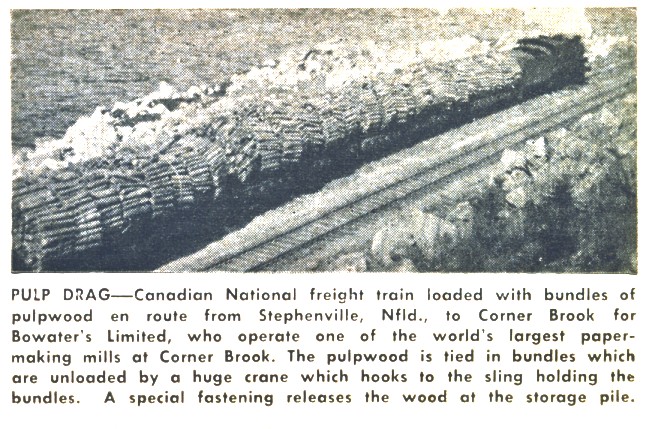
Reminiscent of an grossly overloaded prospector's mule, a Newfoundland
steam locomotive tugs its train along beside a rocky breakwater. For
general interest readers, a "drag" is an underpowered freight train.
The Reid's lost their Corner Brook mill involvement in 1926 as the
International Power and Paper Company came in, and the mill is perhaps most
famously known as a Bowater's mill - as in Sir Eric Bowater. This photo
is reproduced from a minuscule reference in a ancient Canadian National
Railway's staff magazine from the early 1950s.
This precarious method of carrying pulp logs was replaced by the use
of bulkhead flatcars in later years ... Consistent with modern practice,
the logs were then loaded across the centre axis and bookended
by the bulkheads at each end.
Whether it was uprooting its
dispatching office to make things run efficiently ...
or using the general purpose cars it had as efficiently as possible ...
the Newfoundland railroaders always seemed to do their best with the
limited resources they had.
Below are additional photos of Bowater operations taken from other
Canadian National staff magazines.
Workers roll out newsprint for loading on a ship.
The image
at the centre of the roll is a Newfoundland dog's head with its tongue
out .
A special sling is used to hoist the rolls aboard.
For Canadiana trivia fans, it was at this mill that
Grand Falls native Gordon Pinsent
performed in the 1971 film adaptation
of his novel
"The Rowdyman" ...
"You're lovely! ... tell your
mother!"
Above in 1988, trucks at the Corner Brook mill are dwarfed
by the pulp wood stockpiles.
On this humid dark day a ship's superstructure
can be seen against the dark hills of Humber Arm.
Like steel mills, paper
mills never seem to shut down, they just change owners.
Corner Brook - Platinum Collector's Edition
A special bonus feature just for you
:
An interesting artifact of the old methods of moving pulp logs down from
the Grand Lake reservoir
is this log flume we found in the Deer Lake area
one sunny day ...
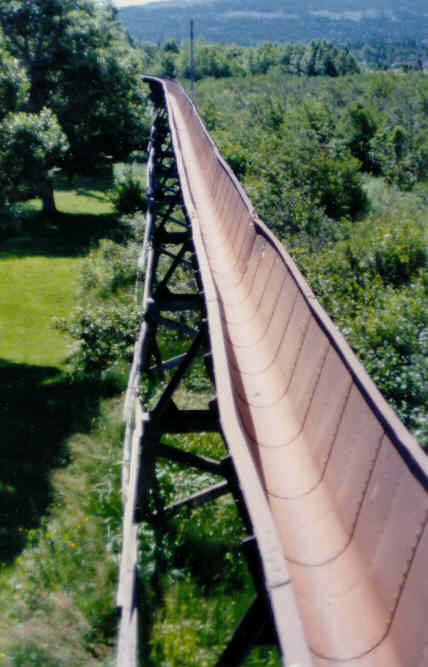
Missing is the steam locomotive roundhouse which would normally
surround it, is an old turntable.
Perhaps a covered turntable was originally
used at this location
and perhaps the gap in the concrete is just a big
"clean out door" for a bucket loader to use in winter?
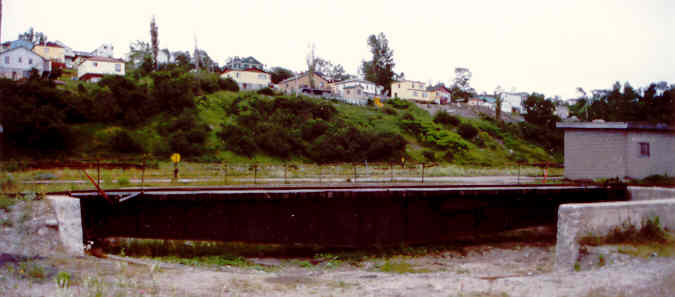
Here is the only bona fide train we saw during our June 1988 visit to Newfoundland.
An eastbound rolls into Seal Head Yard.
Almost immediately, the Corner Brook switcher started working on the tailend of the train.
Perhaps it was because the railway's end was very near and morale was low,
but I have NEVER heard harder switching and rougher joints than I did from
that crew.
Finally, looking southwest, back to Corner Brook. The main track is beside the
rock cut.
The mill is beyond the container port and part of the town can be seen
beyond that.


